Experimental Study of the Thermal and Dynamic Behaviors of Polypropylene Fiber-Reinforced Concrete
Abstract
:1. Introduction
2. Materials and Methods
2.1. Test Material
2.2. Test Equipment
2.3. Principles of Split Hopkinson Pressure Bar (SHPB)
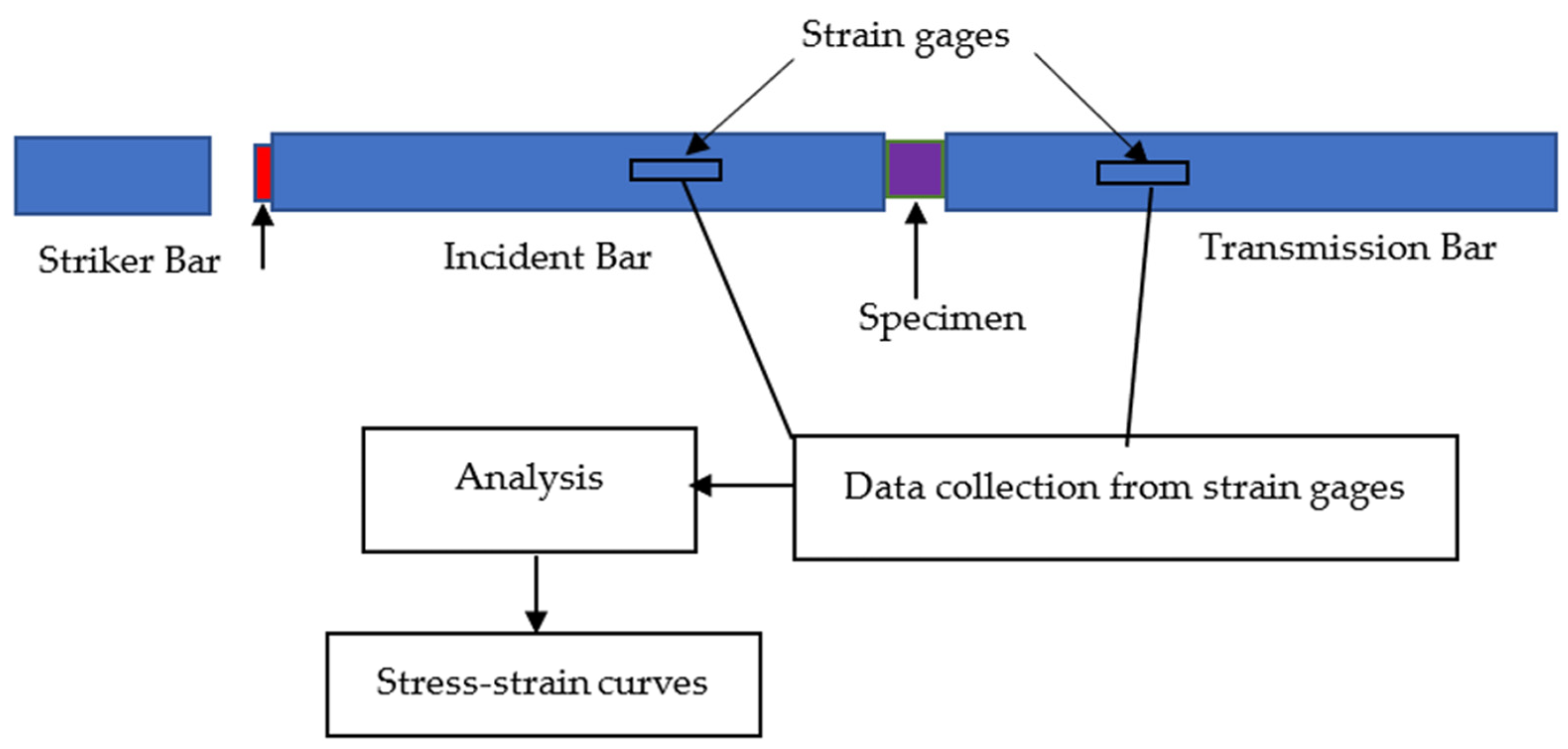
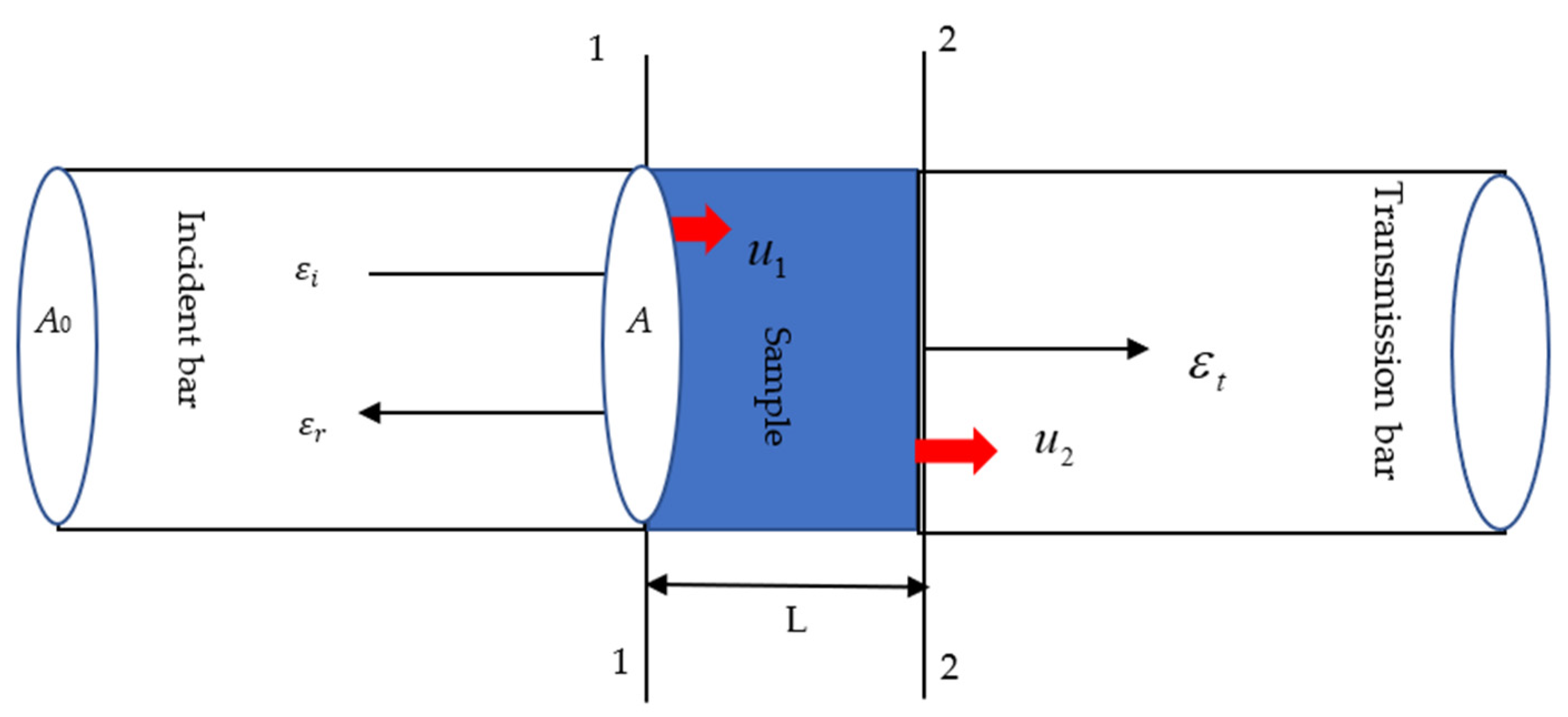
3. Test Results
3.1. High-Performance Concrete Insulation Measures
3.2. SHPB Test Results
4. Discussion
4.1. Effect of the Loading Rate on Dynamic HPC Strength
4.2. Effect of the High Temperature on Dynamic HPC Strength
5. Conclusions
Author Contributions
Funding
Institutional Review Board Statement
Informed Consent Statement
Data Availability Statement
Conflicts of Interest
References
- Mansouri, I.; Shahheidari, F.S.; Hashemi, S.M.A.; Farzampour, A. Investigation of steel fiber effects on concrete abrasion resistance. Adv. Concr. Constr. 2020, 9, 367–374. [Google Scholar]
- Chalangaran, N.M.M. Jabbari Experimental Investigation into Sound Transmission Loss through Concrete Containing Recycled Rubber. Amirkabir J. Mech. Eng. 2019, 51, 1–3. [Google Scholar]
- Farzampour, A. Compressive Behavior of Concrete under Environmental Effects. In Compressive Strength of Concrete; IntechOpen: London, UK, 2019; pp. 1–14. [Google Scholar]
- An, H.; Song, Y.; Liu, L.; Meng, X. Experimental Study of the Compressive Strengths of Basalt Fiber-Reinforced Concrete after Various High-Temperature Treatments and Cooling in Open Air and Water. Appl. Sci. 2021, 11, 8729. [Google Scholar] [CrossRef]
- Liu, L.H.M. An Experimental study of compressive failure of concrete under static and dynamic loads. Arch. Civ. Eng. 2020, 66, 427–441. [Google Scholar] [CrossRef]
- An, H.L. Liu Numerical Study of Dynamic Behaviors of Concrete Under Various Strain Rates. Arch. Civ. Eng. 2019, 65, 21–36. [Google Scholar] [CrossRef] [Green Version]
- An, H.; Hou, S.; Liu, L. Experimental and Numerical Study of the Concrete Stress and Fracture Propagation Processes by Blast. Eng. Lett. 2019, 27, 669–675. [Google Scholar]
- Zhang, P.; Kang, L.; Wang, J.; Guo, J.; Hu, S.; Ling, Y. Mechanical properties and explosive spalling behavior of steel-fiber-reinforced concrete exposed to high temperature—A review. Appl. Sci. 2020, 10, 2324. [Google Scholar] [CrossRef] [Green Version]
- Chen, B.J. Liu Residual strength of hybrid-fiber-reinforced high-strength concrete after exposure to high temperatures. Cem. Concr. Res. 2004, 34, 1065–1069. [Google Scholar] [CrossRef]
- Ren, W.; Xu, J.; Su, H. Dynamic compressive behavior of basalt fiber reinforced concrete after exposure to elevated temperatures. Fire Mater. 2016, 40, 738–755. [Google Scholar] [CrossRef]
- Kumar, A. The effect of stress rate and temperature on the strength of basalt and granite. Geophysics 1968, 33, 501–510. [Google Scholar] [CrossRef]
- Bažant, Z.P.; Shang-Ping, B.; Ravindra, G. Gettu Fracture of rock: Effect of loading rate. Eng. Fract. Mech. 1993, 45, 393. [Google Scholar] [CrossRef]
- Blanton, T. Effect of strain rates from 10-2 to 10 sec-1 in triaxial compression tests on three rocks. In International Journal of Rock Mechanics and Mining Sciences & Geomechanics Abstracts; Elsevier: Amsterdam, The Netherlands, 1981. [Google Scholar]
- Johnson, G.R.; Stryk, R.A.; Holmquist, T.J.; Beissel, S.R. Numerical Algorithms in A Lagrangian Hydrocode; Technical Report; Defense Technical Information Center: Virginia, FL, USA, 1997.
- Li, X.; Lok, T.; Zhao, J. Dynamic characteristics of granite subjected to intermediate loading rate. Rock Mech. Rock Eng. 2005, 38, 21–39. [Google Scholar] [CrossRef]
- Kolsky, H. Stress Waves in Solids; Courier Corporation: North Chelmsford, MA, USA, 1963; Volume 1098. [Google Scholar]
- Tedesco, J.; Hughes, M.; Ross, C. Numerical simulation of high strain rate concrete compression tests. Comput. Struct. 1994, 51, 65–77. [Google Scholar] [CrossRef]
- Gálvez, F.; Rodríguez, J.; Sánchez, V. Tensile strength measurements of ceramic materials at high rates of strain. Le J. De Phys. IV 1997, 7, C3-151–C3-156. [Google Scholar] [CrossRef] [Green Version]
- Sukontasukkul, P.; Nimityongskul, P.; Mindess, S. Effect of loading rate on damage of concrete. Cem. Concr. Res. 2004, 34, 2127–2134. [Google Scholar] [CrossRef]
- Zhao, J. Applicability of Mohr—Coulomb and Hoek—Brown strength criteria to the dynamic strength of brittle rock. Int. J. Rock Mech. Min. Sci. 2000, 37, 1115–1121. [Google Scholar] [CrossRef]
- Zhang, Z.X.; Kou, S.Q.; Jiang, L.G.; Lindqvist, P.A. Effects of loading rate on rock fracture: Fracture characteristics and energy partitioning. Int. J. Rock Mech. Min. Sci. 2000, 37, 745–762. [Google Scholar] [CrossRef]
- Dai, F.; Huang, S.; Xia, K.; Tan, Z. Some fundamental issues in dynamic compression and tension tests of rocks using split Hopkinson pressure bar. Rock Mech. Rock Eng. 2010, 43, 657–666. [Google Scholar] [CrossRef]
- Dai, F.; Xia, K.; Zheng, H.; Wang, Y.X. Determination of dynamic rock mode-I fracture parameters using cracked chevron notched semi-circular bend specimen. Eng. Fract. Mech. 2011, 78, 2633–2644. [Google Scholar] [CrossRef]
- Eissa, E.A. Kazi Relation between static and dynamic Young’s moduli of rocks. In International Journal of Rock Mechanics and Mining Sciences & Geomechanics Abstracts; Elsevier: Amsterdam, The Netherlands, 1988. [Google Scholar]
- Mahanta, B.; Tripathy, A.; Vishal, V.; Singh, T.N.; Ranjith, P.G. Effects of strain rate on fracture toughness and energy release rate of gas shales. Eng. Geol. 2017, 218, 39–49. [Google Scholar] [CrossRef]
- Zhang, Z. Laboratory Studies of Dynamic Rock Fracture and in-Situ Measurements of Cutter Forces for a Boring Machine. Doctoral Dissertation, Luleå Tekniska Universitet, Luleå, Sweden, 2001. [Google Scholar]
- Li, X.B.; Yin, T.B.; Zhou, Z.L.; Hong, L.; Gao, K. Study of dynamic properties of siltstone under coupling effects of temperature and pressure. Chin. J. Rock Mech. Eng. 2010, 29, 2377–2384. [Google Scholar]
- Yin, T.B.; Li, X.B.; Ye, Z.Y.; Gong, F.Q.; Zhou, Z.L. Energy dissipation of rock fracture under thermo-mechanical coupling and dynamic disturbances. Chin. J. Rock Mech. Eng. 2013, 32, 1197–1202. [Google Scholar]
- Savastano, H., Jr.; Santos, S.F.; Radonjic, M.; Soboyejo, W.O. Fracture and fatigue of natural fiber-reinforced cementitious composites. Cem. Concr. Compos. 2009, 31, 232–243. [Google Scholar] [CrossRef]
- Bhat, T.; Chevali, V.; Liu, X.; Feih, S.; Mouritz, A.P. Fire structural resistance of basalt fibre composite. Compos. Part A Appl. Sci. Manuf. 2015, 71, 107–115. [Google Scholar] [CrossRef]
- Sim, J.; Park, C.D.; Moon, Y. Characteristics of basalt fiber as a strengthening material for concrete structures. Compos. Part B Eng. 2005, 36, 504–512. [Google Scholar] [CrossRef]
- Noushini, A.; Samali, B.; Vessalas, K. Effect of polyvinyl alcohol (PVA) fibre on dynamic and material properties of fibre reinforced concrete. Constr. Build. Mater. 2013, 49, 374–383. [Google Scholar] [CrossRef]
- Arisoy, B.; Wu, H.C. Material characteristics of high performance lightweight concrete reinforced with PVA. Constr. Build. Mater. 2008, 22, 635–645. [Google Scholar] [CrossRef]
- Wu, H.; Lin, X.; Zhou, A. A review of mechanical properties of fibre reinforced concrete at elevated temperatures. Cem. Concr. Res. 2020, 135, 106117. [Google Scholar] [CrossRef]
- Ríos, J.D.; Leiva, C.; Ariza, M.P.; Seitl, S.; Cifuentes, H. Analysis of the tensile fracture properties of ultra-high-strength fiber-reinforced concrete with different types of steel fibers by X-ray tomography. Mater. Des. 2019, 165, 107582. [Google Scholar] [CrossRef]
- Zheng, W.; Luo, B.; Lu, S. Compressive and tensile strengths of reactive powder concrete with hybrid fibres at elevated temperatures. Rev. Romana De Mater.-Rom. J. Mater. 2014, 44, 36–45. [Google Scholar]
- Schneider, K.; Michel, A.; Liebscher, M.; Terreri, L.; Hempel, S.; Mechtcherine, V. Mineral-impregnated carbon fibre reinforcement for high temperature resistance of thin-walled concrete structures. Cem. Concr. Compos. 2019, 97, 68–77. [Google Scholar] [CrossRef]
- Goldfeld, Y.; Rabinovitch, O.; Fishbain, B.; Quadflieg, T.; Gries, T. Sensory carbon fiber based textile-reinforced concrete for smart structures. J. Intell. Mater. Syst. Struct. 2016, 164, 273–282. [Google Scholar] [CrossRef]
- Kang, S.T.; Choi, J.I.; Koh, K.T.; Lee, K.S.; Lee, B.Y. Hybrid effects of steel fiber and microfiber on the tensile behavior of ultra-high performance concrete. Compos. Struct. 2016, 145, 37–42. [Google Scholar] [CrossRef]
- Larisa, U.; Solbon, L.; Sergei, B. Fiber-reinforced Concrete with Mineral Fibers and Nanosilica. Procedia Eng. 2017, 195, 147–154. [Google Scholar] [CrossRef]
- Khan, M.; Ali, M. Use of glass and nylon fibers in concrete for controlling early age micro cracking in bridge decks. Constr. Build. Mater. 2016, 125, 800–808. [Google Scholar] [CrossRef]
- Solhmirzaei, R.; Kodur, V.K.R. Modeling the response of ultra high performance fiber reinforced concrete beams. Procedia Eng. 2017, 210, 211–219. [Google Scholar] [CrossRef]
- Yang, L.; Lin, X.; Gravina, R.J. Evaluation of dynamic increase factor models for steel fibre reinforced concrete. Constr. Build. Mater. 2018, 190, 632–644. [Google Scholar] [CrossRef]
- Yang, L.; Lin, X.; Li, H.; Gravina, R.J. A new constitutive model for steel fibre reinforced concrete subjected to dynamic loads. Compos. Struct. 2019, 221, 110849. [Google Scholar] [CrossRef]
- Ma, Q.; Guo, R.; Zhao, Z.; Lin, Z.; He, K. Mechanical properties of concrete at high temperature—A review. Constr. Build. Mater. 2015, 93, 371–383. [Google Scholar] [CrossRef]
- Jyotsna Devi, P.; Srinivasa Rao, K. Compressive behaviour of steel fibre reinforced concrete at high temperatures. Indian Concr. J. 2015, 89, 21–31. [Google Scholar]
- Kazmi, S.M.S.; Munir, M.J.; Wu, Y.F.; Patnaikuni, I.; Zhou, Y.; Xing, F. Axial stress-strain behavior of macro-synthetic fiber reinforced recycled aggregate concrete. Cem. Concr. Compos. 2019, 97, 341–356. [Google Scholar] [CrossRef]
- Kazmi, S.M.S.; Munir, M.J.; Wu, Y.F.; Patnaikuni, I. Effect of macro-synthetic fibers on the fracture energy and mechanical behavior of recycled aggregate concrete. Constr. Build. Mater. 2018, 189, 857–868. [Google Scholar] [CrossRef]
- Kaufmann, W. Material characterisation of macro synthetic fibre reinforced concrete. Cem. Concr. Compos. 2017, 84, 124–133. [Google Scholar]
- Mindeguia, J.C.; Pimienta, P.; Noumowé, A.; Kanema, M. Temperature, pore pressure and mass variation of concrete subjected to high temperature—Experimental and numerical discussion on spalling risk. Cem. Concr. Res. 2010, 40, 477–487. [Google Scholar] [CrossRef]
- Bangi, M.R.T. Horiguchi Pore pressure development in hybrid fibre-reinforced high strength concrete at elevated temperatures. Cem. Concr. Res. 2011, 41, 1150–1156. [Google Scholar] [CrossRef] [Green Version]
- Ministry of Housing and Urban-Rural Construction of the People’s Republic of China. Specification for Mix Proportion Design of Ordinary Concrete JGJ55-2011. Industrial Standard of the People’s Republic of China 2011.12; Ministry of Housing and Urban-Rural Construction of the People’s Republic of China: Beijing, China, 2011.
- Ministry of Housing and Urban-Rural Construction of the People’s Republic of China. Standard for Test Method of Mechanical Properties on Ordinary Concrete; The State Standard of the People’s Republic of China: Beijing, China, June 2003.
- Association of Senior Technologists of Tsinghua University. Technical Spcification for Application of High Performance Concrete; China Science and Technology Press: Beijing, China, 2006. [Google Scholar]
- Han, Z.G. On the use of SHPB techniques to determine the dynamic behavior of materials in the range of small strains. Int. J. Solids Struct. 1996, 33, 3363–3375. [Google Scholar]
- Follansbee, P.S.; Frantz, C. Wave Propagation in the Split Hopkinson Pressure Bar. J. Eng. Mater. Technol. 1983, 105, 61–66. [Google Scholar] [CrossRef]
- An, H.; Zeng, T.; Zhang, Z.; Liu, L. Experimental Study of the Rock Mechanism under Coupled High Temperatures and Dynamic Loads. Adv. Civ. Eng. 2020, 2020, 8866621. [Google Scholar] [CrossRef]
- Farzampour, A. Temperature and humidity effects on behavior of grouts. Adv. Concr. Constr. 2017, 5, 659–669. [Google Scholar] [CrossRef]
- Chalangaran, N.; Farzampour, A.; Paslar, N. Nano Silica and Metakaolin Effects on the Behavior of Concrete Containing Rubber Crumbs. CivilEng 2020, 1, 264–274. [Google Scholar] [CrossRef]
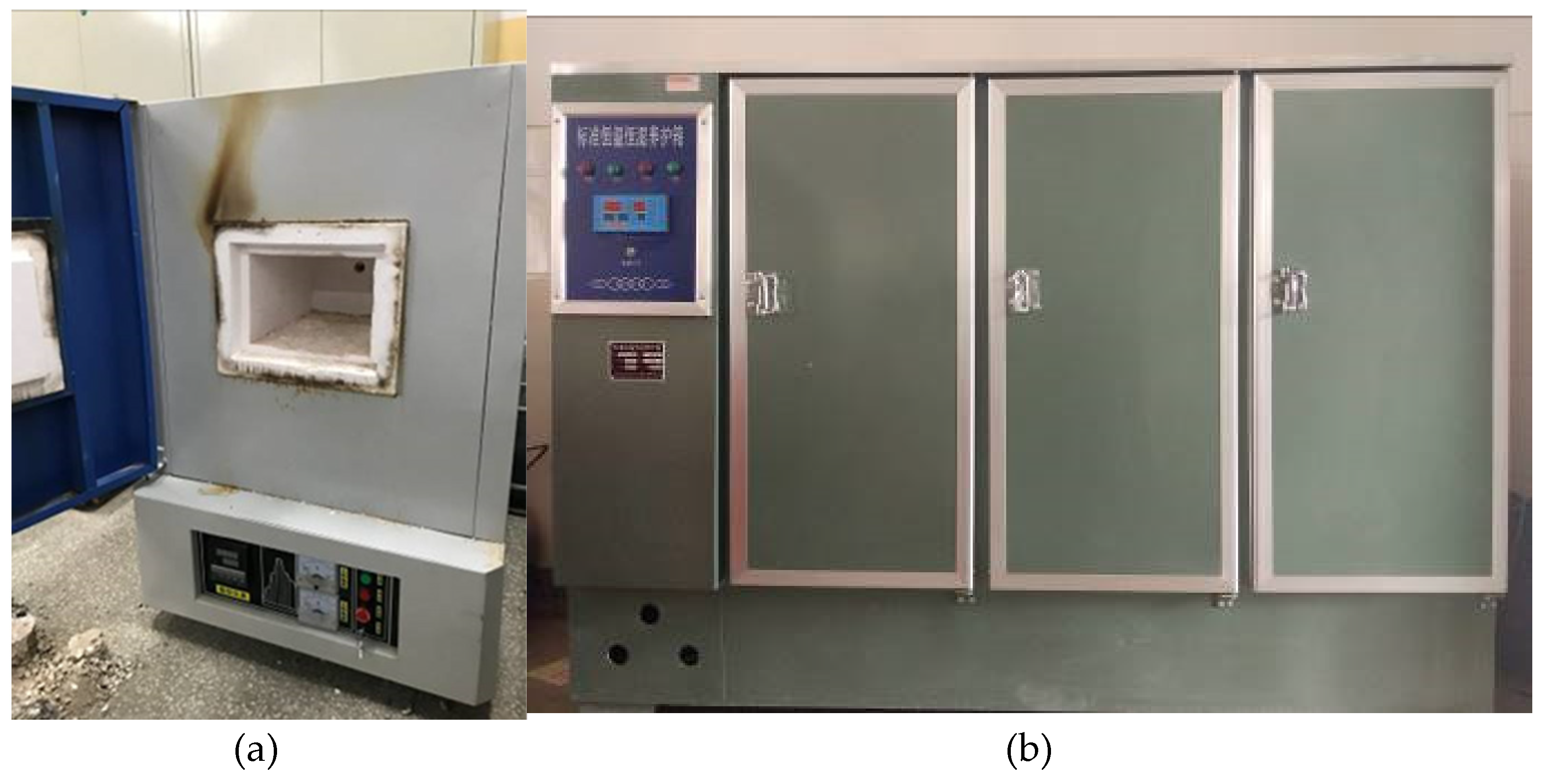

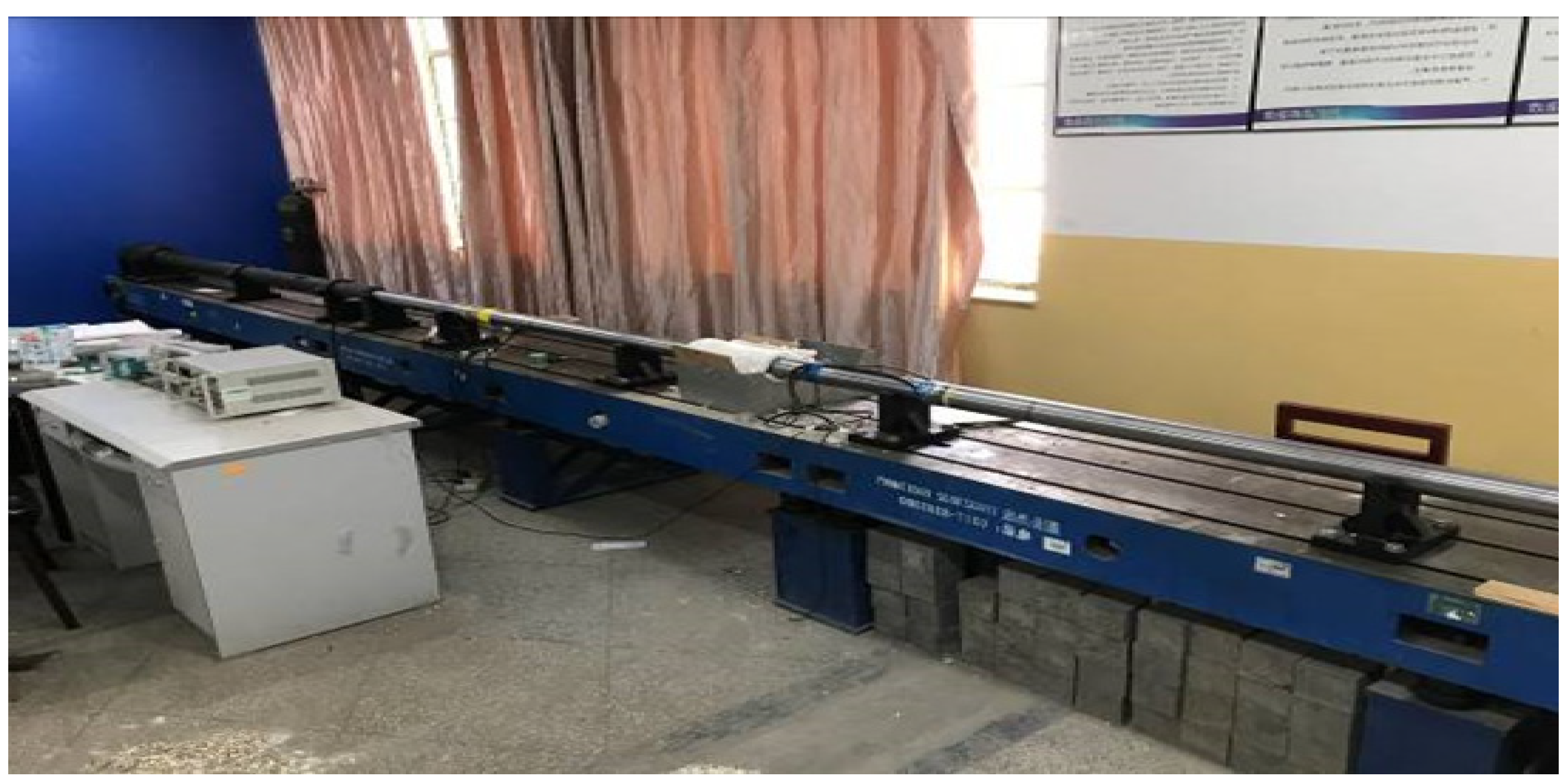
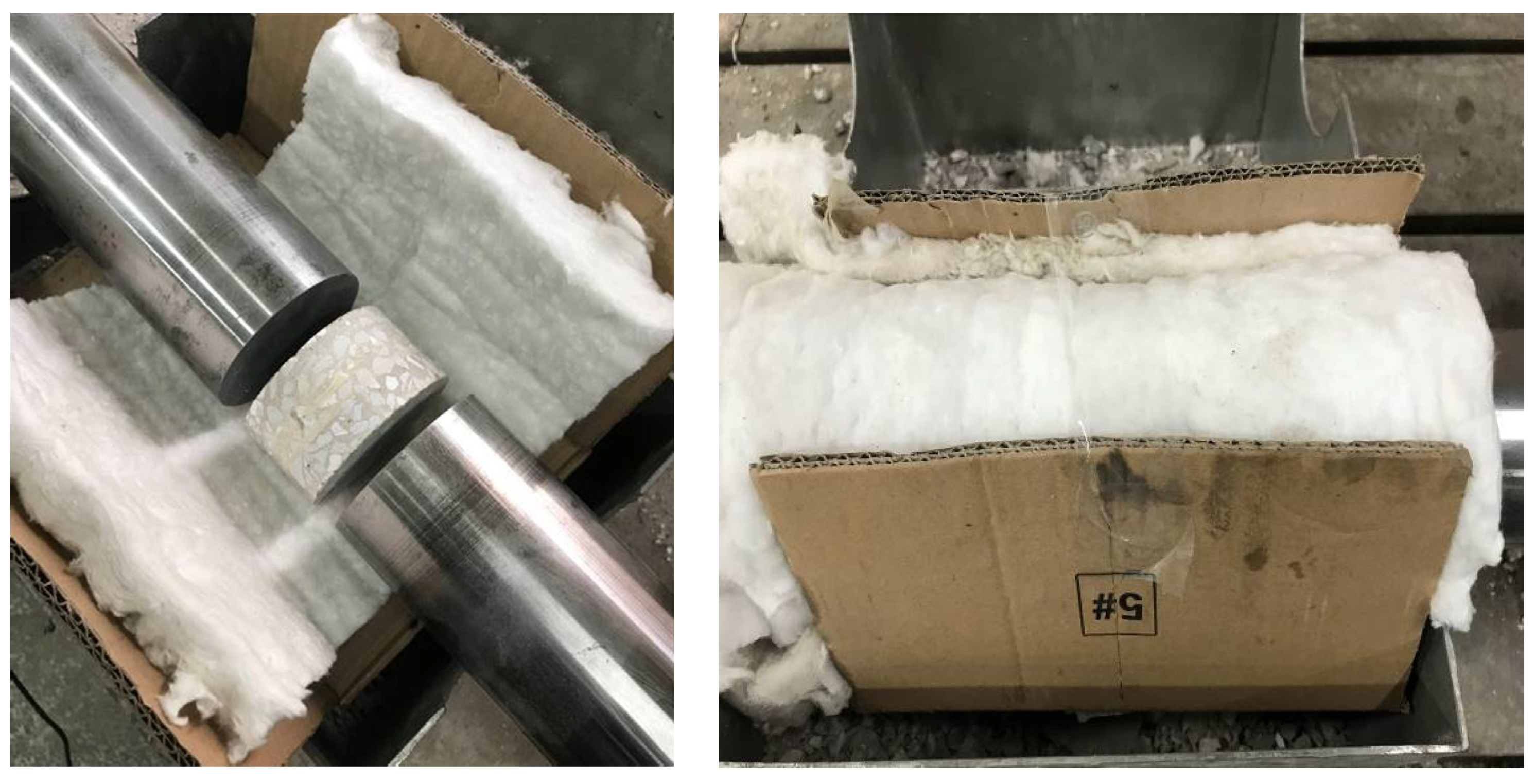

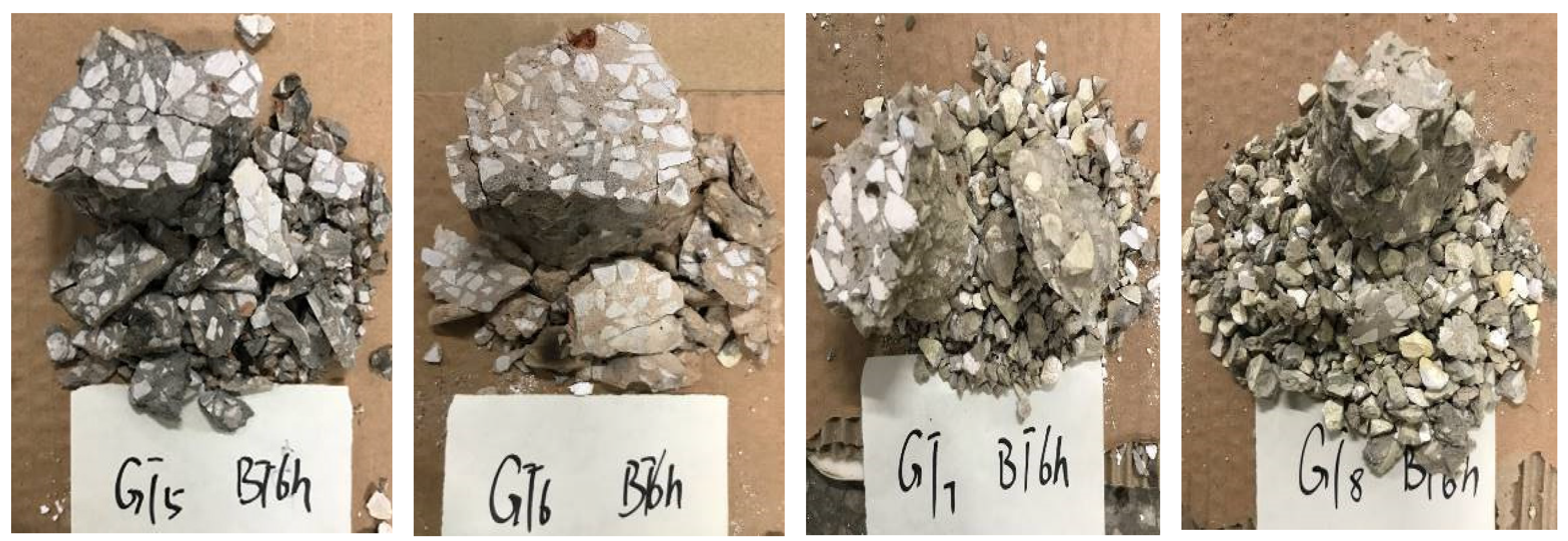
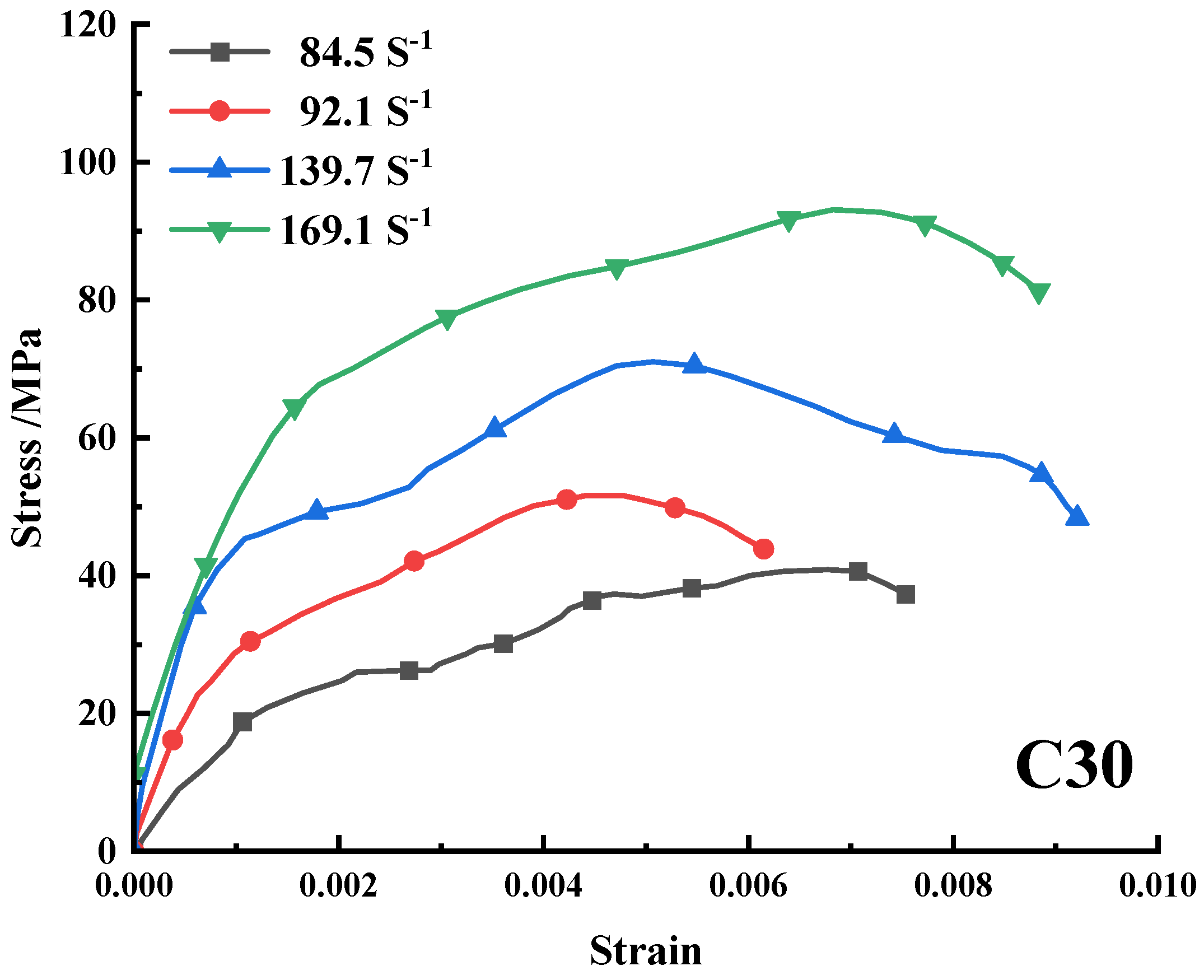
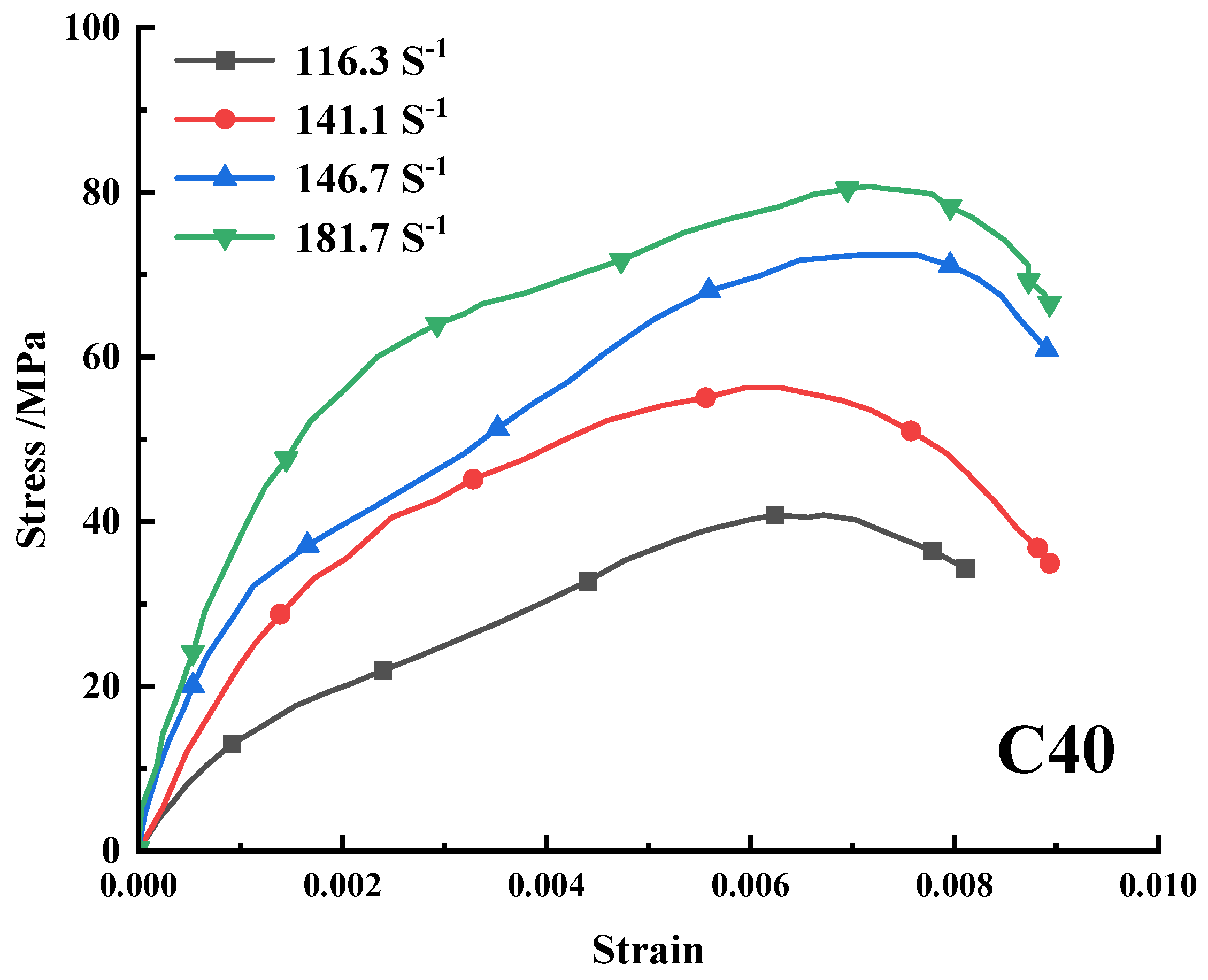
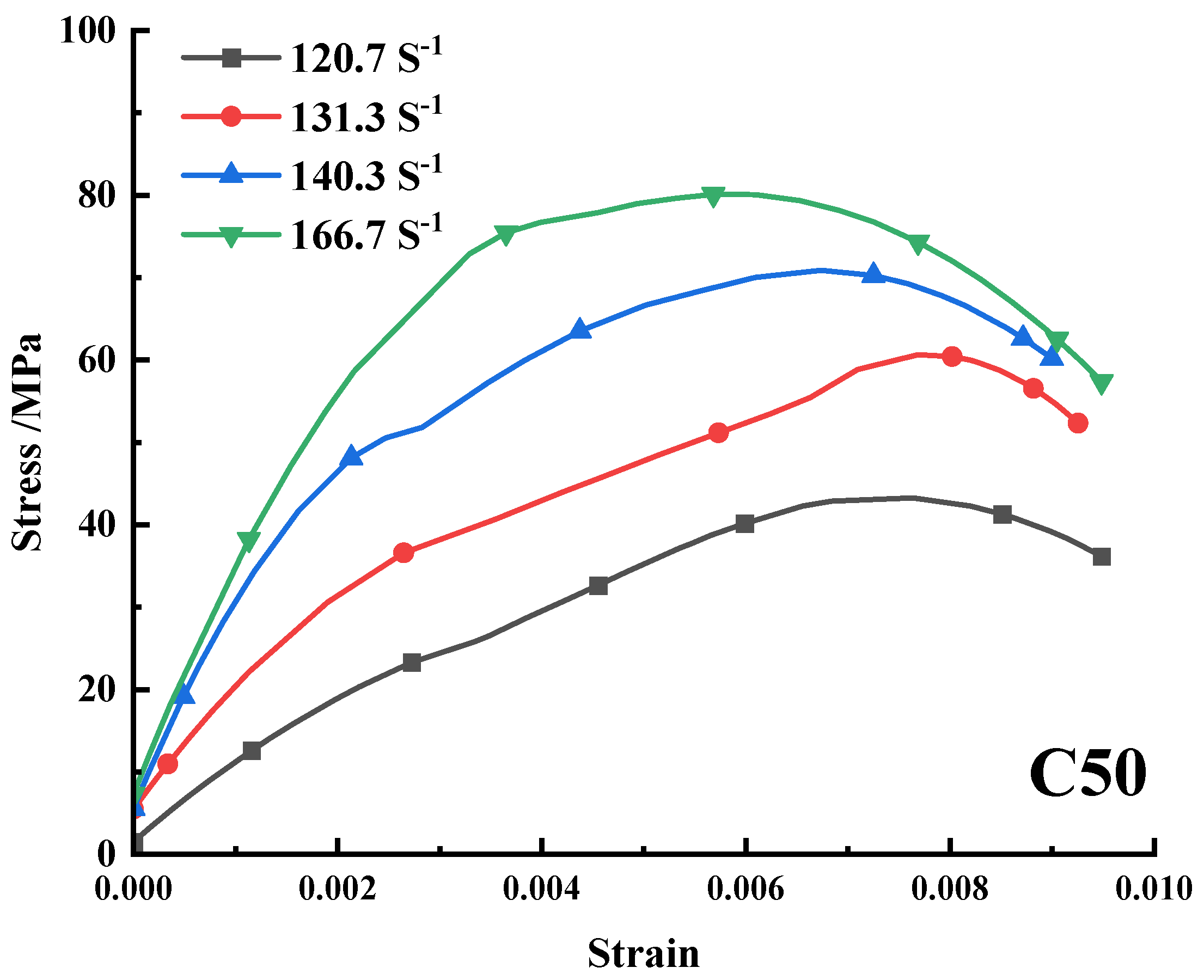
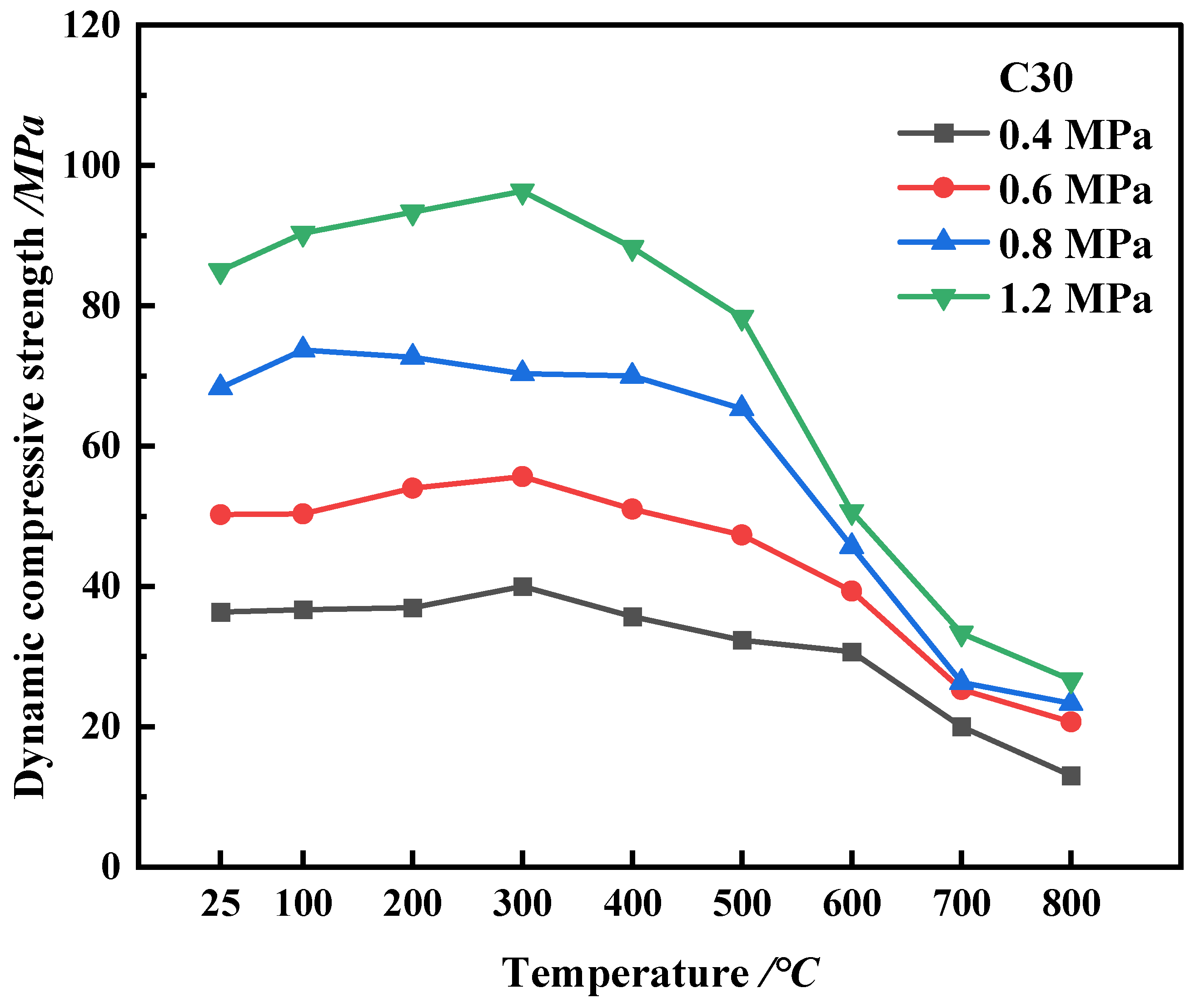
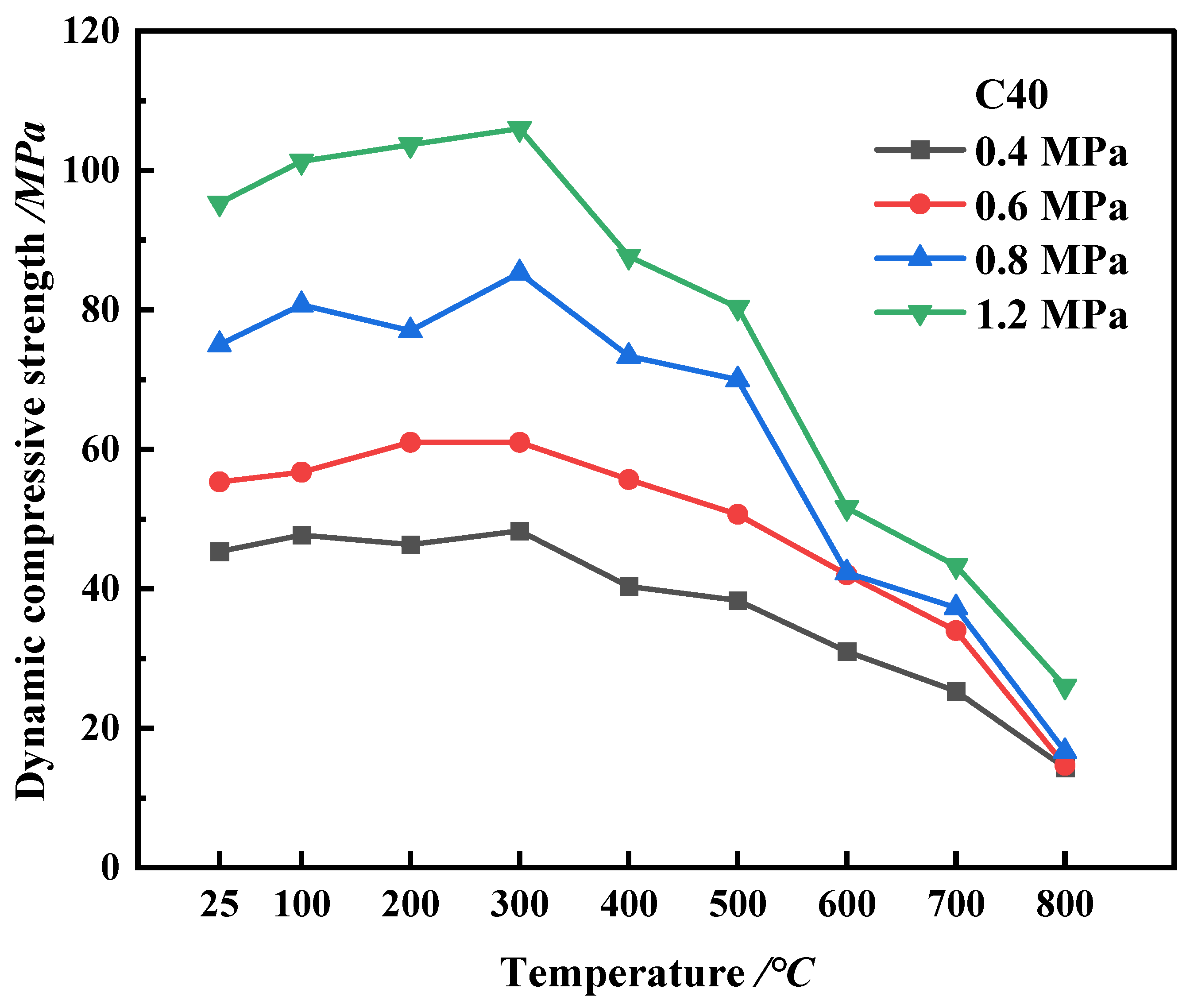

| Chemical Composition | SiO2 | CaO | MgO | Fe2O3 | NaO | K2O |
|---|---|---|---|---|---|---|
| % | 20.7 | 64.0 | 1.82 | 4.41 | 0.2 | 1.2 |
| Cement Type | Setting Time (min) | Compressive Strength (MPa) | Flexural Strength (Mpa) | |||
|---|---|---|---|---|---|---|
| Initial Setting | Final Setting | 3 day | 28 day | 3 day | 28 day | |
| P.O42.5 | 180 | 240 | 20.7 | 45.1 | 6.1 | 10.2 |
| Chemical Composition | SiO2 | Al2O3 | CaO | MgO | SO3 | Fe2O3 | Na2O |
|---|---|---|---|---|---|---|---|
| % | 40.2 | 14.5 | 1.9 | 1.5 | 1.6 | 1.7 | 1.2 |
| Characteristics | Parameters | Characteristics | Parameters |
|---|---|---|---|
| Color | White or faint yellow | Shape | Monofilament bundle |
| Density | 1.18 (g/cm3) | Equivalent diameter | 9–30 um |
| Length | 3–9 (mm) | Melting point | 220 (°C) |
| Acid resistance | Excellent | Alkali resistance | Excellent |
| Tensile strength | ≥900 Mpa | Elongation at break | ≥15–25 (%) |
| Elastic modulus | ≥13,000 Mpa | Water absorption | Water resistance |
| Grade | Water | Cement | River Sand | Stone | Polypropylene Fiber | Water—Binder Ratio | Sand Ratio |
|---|---|---|---|---|---|---|---|
| N-C30 | 215 | 360 | 693 | 1132 | - | 0.60 | 38% |
| N-C40 | 215 | 450 | 659 | 1076 | - | 0.48 | 38% |
| N-C50 | 215 | 540 | 625 | 1020 | - | 0.40 | 38% |
| N-C30-B | 215 | 360 | 693 | 1132 | 1 | 0.60 | 38% |
| N-C40-B | 215 | 450 | 659 | 1076 | 1 | 0.48 | 38% |
| N-C50-B | 215 | 540 | 625 | 1020 | 1 | 0.40 | 38% |
| Grade | Water | Cement | Fly Ash | Silica Fume | River Sand | Stone | Polypropylene Fiber | Water Reducing Agent | Water—Binder Ratio | Sand Ratio |
|---|---|---|---|---|---|---|---|---|---|---|
| H-C30 | 160 | 234 | 108 | 18 | 714 | 1166 | 1 | 7.2 | 0.44 | 38% |
| H-C40 | 160 | 292.5 | 135 | 22.5 | 680 | 1110 | 1 | 9 | 0.36 | 38% |
| H-C50 | 160 | 351 | 162 | 27 | 646 | 1054 | 1 | 10.8 | 0.30 | 38% |
| H-C30-B | 160 | 234 | 108 | 18 | 714 | 1166 | - | 7.2 | 0.44 | 38% |
| H-C40-B | 160 | 292.5 | 135 | 22.5 | 680 | 1110 | - | 9 | 0.36 | 38% |
| H-C50-B | 160 | 351 | 162 | 27 | 646 | 1054 | - | 10.8 | 0.30 | 38% |
Publisher’s Note: MDPI stays neutral with regard to jurisdictional claims in published maps and institutional affiliations. |
© 2021 by the authors. Licensee MDPI, Basel, Switzerland. This article is an open access article distributed under the terms and conditions of the Creative Commons Attribution (CC BY) license (https://creativecommons.org/licenses/by/4.0/).
Share and Cite
Lei, L.; Dong, L.; An, H.; Fan, Y.; Wang, Y. Experimental Study of the Thermal and Dynamic Behaviors of Polypropylene Fiber-Reinforced Concrete. Appl. Sci. 2021, 11, 10757. https://doi.org/10.3390/app112210757
Lei L, Dong L, An H, Fan Y, Wang Y. Experimental Study of the Thermal and Dynamic Behaviors of Polypropylene Fiber-Reinforced Concrete. Applied Sciences. 2021; 11(22):10757. https://doi.org/10.3390/app112210757
Chicago/Turabian StyleLei, Liu, Lizhe Dong, Huaming An, Yuqing Fan, and Ya Wang. 2021. "Experimental Study of the Thermal and Dynamic Behaviors of Polypropylene Fiber-Reinforced Concrete" Applied Sciences 11, no. 22: 10757. https://doi.org/10.3390/app112210757






